Robert Walter Weir (1803-1889)
[21 Jul 2020 Update: I've added pages for all paintings I have an image of, with further details. See the master list of nearly 500 works.]
Artist
This contains some information about the paintings and others works of Robert Walter Weir.
His paintings are normally signed 'Robt. W. Weir', with some as 'R. W. Weir or 'R. W. W.' (sometimes followed by the year).
He created at least 150 oil paintings, in addition to hundeds of pen and ink drawings and watercolors. Some notable facts about Robert Walter Weir include:
- His most prominent work is Embarkation of the Pilgrims, at the Rotunda at the U.S. Capitol Rotunda.
- The highest auction price was $1,202,500 in 2008 for Greenwich Boat Club.
- More recently, one of his two Landing of the Henry Hudson paintings sold at auction in May, 2018 for $200,000.
- His art was featured on a U.S. $50 bill.
- Over 20 museums have (or perhaps recently had) Robert Walter Weir paintings in their collections.
- Two of his 16 children also became prominent painters: Julian Alden Weir and John Ferguson Weir. Several other descendants of his are also artists.
Full List of Works
I have put together as complete a list as I could of Robert Walter Weir's works. It contains nearly 500
works, and is almost certainly the most complete list of Robert Walter Weir paintings anywhere.
There are, however, likely hundreds of his works not listed. He produced many sketches, many of which likely do not have his name on them.
Likewise, he produced many paintings (especially portraits) without his signature on them. Most of these works, while not 'lost forever',
will likely be 'unattributed forever'. Likewise, there are likely some duplicate entries (for example, are "Aaron Converting His Staff into a Serpent"
and "Moses and the Brazen Serpent" two different paintings, or two different names for the same painting?).
Sample Works:
| Historical |
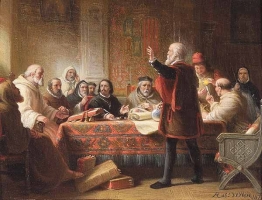
Columbus Before the Council at Salamanca, 1877
|
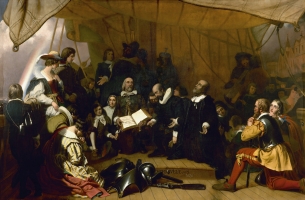
Embarkation of the Pilgrims, 1843
|
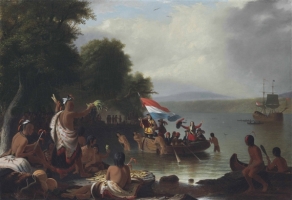
Landing of the Henry Hudson, 1835
|
| Religious |
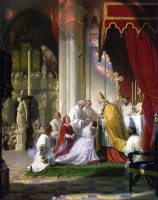
The Taking of the Veil, 1863
|
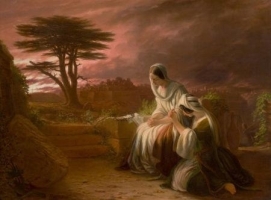
Two Marys at the Sepulchre, 1865
|
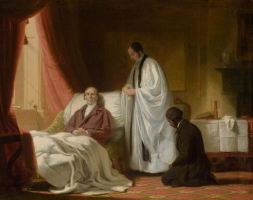
The Last Communion of Henry Clay, 1852
|
| Portraits |
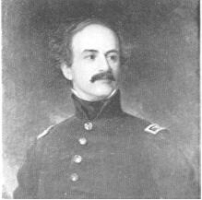
Portrait of Col. Robert E. Lee, 1852
|
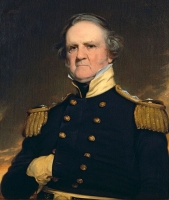
Portrait of General Winfield Scott, ca. 1855
|
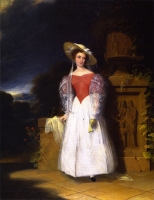
Lady in a Red Bodice, ca. 1830
|
| Genre Paintings |
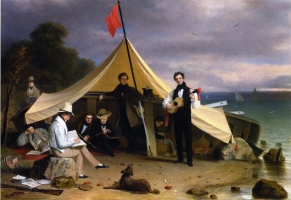
The Greenwich Boat Club, 1833
|
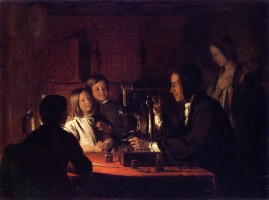
The Microscope, 1849
|
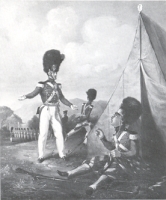
U.S. Volunteer Militia, ca. 1842
|
| Landscapes |
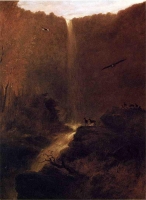
Kaaterskill Falls, New York, ca. 1850
|
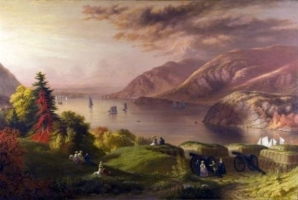
View of the Hudson River, 1864
|
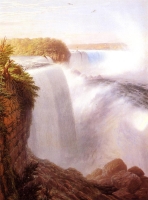
Niagara Falls, ca. 1855
|
Copyrights...
Copyright law is complex. Since Robert Walter Weir died in 1889, however, all of his works should be in the public domain.
However, it is possible for someone to claim that they altered the work enough to justify a copyright (just on the alterations).
Hard work doesn't count; spending hours to get an exactly rectangular image doesn't create a new work.
My understanding is that images from auction houses, galleries and museums should all be public domain (intentionally altering
an image to get it to deviate from the most faithful reproduction possible would likely be fraud; likewise, museums should be
attempting to get the most faithful reproductions possible). That said, it is *possible* that images of Robert Walter Weir's works
could be copyrighted. I do not claim a copyright in any of the images on this site (although the source of the images in theory could).
I have not detected any copyrightable alterations, or seen a single reference suggesting a reason any of these images should not be
public domain.
Painting Names
Many Robert Walter Weir paintings have more than one name.
Sometimes, it is a matter of shortening a long name ("Christ In The Garden of Gethsemane" to "Christ in the Garden").
Some extraneous titles appear to be due using memory, rather than a written title, to refer to a painting ("Christ's Journey to Emmaus", "Christ on the Way to Emmaus, Christ on His Way to Emmaus", "The Way to Emmaus").
Very few paintings have a title written on them, so sometimes an owner, auctioneer, or art historians will come up with a name, as "Untitled" often doesn't cut it (e.g. "Robed Scholar" for "The Old Merchant").
In at least one case, an auctioneer (or perhaps owner) appears to have embellished the truth for purposes of greed, such as the painting auctioned as "Amerigo Vespucci" (Weir titled it "The Old Merchant").
To deal with this, I record the 'best' name I can determine, and have a separate database field for alternate names. If I know Weir had a title, I normally would use that (unless another name is much more commonly used). Without knowing what Weir titled the painting, I would normally go with the earliest written reference.
Confusing things further is the fact that Weir made several copies of a fair number of his better known paintings. For those, I normally use the same name for all of them (keeping one entry for each).
Copies/Duplicates
Robert Walter Weir would in many cases make copies of his own works.
One great example is The Taking of the Veil (a/k/a The Consecration of a Nun). He was present for the event in 1826, and made a sketch.
37 years later, he created an oil painting of the same subject (which is among his better known works).
Other examples include The Last Communion of Henry Clay (with at least 2 oil paintings and 3 studies for it), Embarkation of the Pilgrims
(with the original at the U.S. Capitol building painted in 1843, and a replica painted in 1857), Columbus Before the Council at Salamanca
(there appear to be 3 oil paintings and 2 studies/tracings), Moses Viewing the Promised Land (the same scene painted in two fairly different ways),
and even his portrait of General Winfield Scott (it appears he made 5 copies of this, several very similar to one another), Washington's Headquarters at Newburgh
(one with cows in front, one without), and View of the Hudson River (with about 3 very similar versions).
Credits
A number of people deserve mention on this page, for publishing information about Robert Walter Weir:
- Irene Weir, one of Robert Walter Weir's granddaughters. She wrote "Robert W. Weir, Artist" (published posthumously in 1947). While it contained no pictures,
it referenced many of his paintings, and included excerpts from a number of letters to/from Robert Walter Weir.
- Kent Ahrens, who published his 304 page dissertation on Robert Walter Weir in 1972. It can be ordered here
(unfortunately, the site does not allow direct links to individual dissertations, so search for 'Robert Walter Weir').
- William H. Gerdts, whose "Robert Weir: Artist and Teacher of West Point" was published in 1976 in conjunction with an exhibition at West Point.
The amount of research done by these individuals is staggering, especially when you consider that you couldn't just go to Google Books and
find in minutes nearly all books referencing an artist. It required tracking down owners of paintings, mailing them, visiting them, taking pictures (and
waiting for them to be developed), and so forth. Without their work, this page likely would never have come to be.
Contact:
If you would like to contact me, feel free to send an email to: spamfree5 [at] rscott.org.














